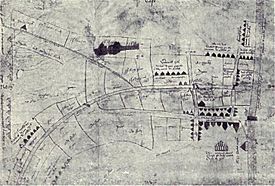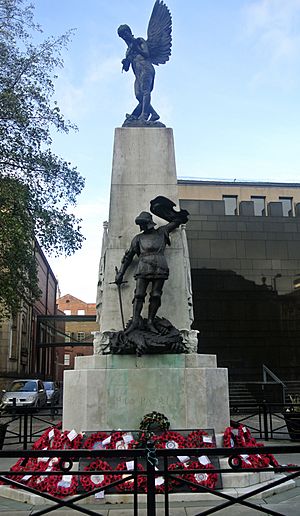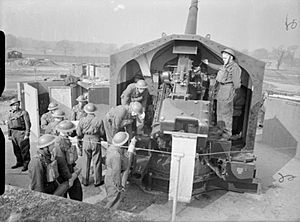History of Leeds facts for kids
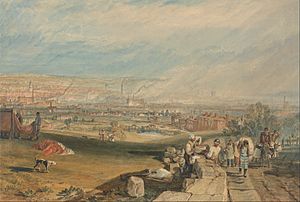
Leeds, in Yorkshire, gets its name from "Loidis." This was an old forested area that belonged to the Celtic kingdom of Elmet. We know that a settlement existed here by the time of the Norman conquest of England in 1066. In 1086, it was a busy farming area, or manor, controlled by Ilbert de Lacy.
Leeds received its first special permission, called a charter, in 1207 from Maurice de Gant. However, it grew quite slowly during the medieval and Tudor times. The town became part of the Duchy of Lancaster and later belonged to the king. This made Leeds a strong supporter of the king (a Royalist) at the start of the English Civil War.
In the 1600s and 1700s, Leeds became rich and grew quickly because of its wool industry. It continued to expand fast during the Industrial Revolution. After a period of decline in the mid-1900s, Leeds became successful again. This happened because new industries, like finance and retail, started to grow.
Contents
What's in a Name? The Story of "Leeds"
The name "Leeds" first appeared as "Loidis" around the year 731. A writer named Bede mentioned it in his book Historia ecclesiastica. He wrote about a church altar in "the region known as Loidis." This shows that "Loidis" was a name for a larger area.
Later, in the 1086 Domesday Book, the name appeared as Ledes, referring to a settlement. The name "Leeds" likely comes from an older Celtic word. Some experts think it might mean "people living by the strongly flowing river." It's also thought that the name might have described a large forest that covered most of the kingdom of Elmet. People from Leeds are sometimes called Loiners, which might also come from "Loidis."
Leeds Long Ago: From Ancient Times to the Normans
We don't have much information about Leeds before the year 730 AD. At that time, Bede mentioned a region, not a specific village or town. So, we know little about any Roman, ancient British, or Anglo-Saxon settlements that might have been where Leeds is today.
However, we have found some clues. Bronze Age objects have been found around Leeds. There were also two Bronze Age burial mounds on Woodhouse Moor. During the Iron Age, the area was linked to the Brigantes tribe. A paved crossing over the River Aire, thought to be from Roman times, has also been found. Roman remains have been discovered in nearby places like Adel and Alwoodley. In 1995, a stone coffin from Roman times was found in Headingley at Beckett's Park.
Important discoveries show that the Leeds area was active in Anglo-Saxon times. Fragments of at least six stone crosses were found in the old Leeds Parish Church. These crosses had decorations from the 800s and 900s, showing Anglo-Scandinavian culture. One cross, now in Leeds Minster, tells the story of Wayland the Smith.
In 2008-2009, the West Yorkshire Hoard was found near Leeds. This small treasure of items from the 600s to 1000s raised Leeds's importance. It seems the Anglo-Saxon settlement had a church, a river crossing, and a main street called Kirkgate. Other signs of Anglo-Saxon life include the old Shire Oak in Headingley. Many local place names ending in ley, like Bramley and Armley, come from the Anglo-Saxon word leah, meaning an open space in the woods.
When the Domesday book was written in 1086, Leeds was called "Ledes." It was a farming area of about 1,000 acres. It had seven small manors, a priest, a church, and a mill. Its value was six pounds. After the Norman Conquest, the seven local lords were replaced by 27 villeins (day-labourers), four sokemen (small landowners), and four bordars (farm workers). The mill was worth four shillings.
Leeds was owned by Ilbert de Lacy, a favorite of William the Conqueror. His lands were likely spared during the "harrying of the North," when many areas were destroyed. So, in 1086, Leeds had at least 200 people, while much of the county was empty.
The settlement had two main parts: the area around the church and the main manor house, half a mile west of the church. In 1399, King Richard II was briefly held captive in Leeds before being moved to Pontefract Castle, where he later died. In 1147, Cistercian monks settled at Kirkstall and began building Kirkstall Abbey around 1152.
Leeds Gets Its First Charter
The de Lacy family gave much of their land in Yorkshire, including Leeds, to the Paynel family. In November 1207, Maurice de Gant, a descendant of the Paynels, gave the people of Leeds their first charter. A charter was a special document that gave a town certain rights and freedoms. Leeds was well-placed on a river crossing and on important trade routes, which the lords wanted to use to make more money.
The charter said that the people of Leeds could have "franchise and free burgage." This meant they had some rights to govern themselves and were considered freemen. They were given plots of land with a small piece of farmland, for which they paid rent. The charter also set up a bailiff to manage the town, collect rents, and fine people. However, the people still had to grind their grain at the lord's mill and bake in his oven.
The new town was built along a wide street, later called Briggate, which was used for a market. There were about 30 plots of land on each side of the street. The first bridge over the River Aire, which gave Briggate its name ("bridge gate"), was recorded in 1384.
Leeds was quite small for a long time. By 1379, it had no more than 300 people. It was one of the smallest towns in Yorkshire. Even in the 1200s, Leeds had different areas: the old settlement around the church, the new town, the manor house and mill, and the town fields. The charter helped Leeds become more successful. By 1334 and 1377, the whole parish had about 1,000 people, with 350 to 400 living in the main town area.
In 1217, Maurice de Gant lost control of Leeds. The land eventually returned to the de Lacy family. When the de Lacy lands were joined with the Duchy of Lancaster through marriage, they became part of the royal family's property. When Henry IV became king, Leeds became property of the Crown.
Growing Up: The Middle Ages and Tudor Times
For four centuries after the Norman invasion, Leeds grew slowly. It didn't have any special military advantages. The important military spot in Yorkshire was nearby Pontefract. At first, Leeds didn't have much trade. Its wool trade might have started from the sheep farming done by the Cistercian monks at Kirkstall Abbey.
The town was mostly about farming. Any trade was just for basic needs like food and clothes. The town itself was small, probably limited to the area around what is now lower Briggate, Kirkgate, and the River Aire. The streets were narrow, unpaved, and dark. Houses were made of wood, often whitewashed and thatched. St Mary's Whitkirk is the only medieval church left, built in the 1400s. Around the town were open fields and meadows, farmed in strips. Beyond these was the Elmet forest.
The Tudor period (1485-1603) was a time of change for Leeds. It went from being a small settlement to a strong town known for trading cloth. In 1470, it was so small that it was described as being "near to Rothwell," which was a bigger market town. By 1536, when John Leland visited, he said Leeds was a nice market town that mostly relied on making cloth. He noted it was as large as Bradford, but not as "quick" or active.
Even so, much of the old way of life remained. The king was now the main lord, and people still had to use the king's mills and ovens. Leeds didn't have its own official town government yet. People were gaining more freedom, but their lives weren't much different from their ancestors'. Until the late 1500s, Leeds was still somewhat like a feudal town.
Education in Leeds isn't mentioned until 1552. A priest named William Sheafield left property for a school. He wanted a teacher to teach children for free. The people of Leeds had to provide a building and pay the teacher ten pounds a year. This was the start of Leeds Grammar School. It became very important by the end of the 1500s.
As the 1500s ended and the 1600s began, the people of Leeds gained two important rights. They could elect their own vicar (church leader) and govern their own town. In 1583, the town bought the right to choose its vicar for £130. From then on, trustees chose the vicars.
In 1626, King Charles I gave Leeds its first charter of incorporation. This charter said Leeds was an old and busy town, known for making woollen cloth. It set up a governing body with one Alderman, nine Burgesses, and twenty Assistants. However, the king still chose who filled any empty spots. Full popular election came later.
The Rise of Woollen Cloth Trade
During the Middle Ages, monks at Kirkstall Abbey were involved in sheep farming. Weaving cloth began in West Yorkshire during the time of King Edward III. Early records show that woollen cloth was traded in an organized market on a bridge over the Aire, at the start of Briggate. This trade followed strict rules and times.
Most of the cloth was made in people's homes in the villages around Leeds. Leeds also had a fulling mill by 1400, which was used to clean and thicken woollen cloth. Cloth dyeing might have also been done in a central place early on.
By the early 1700s, the cloth trade had grown too big for the bridge. Traders then used long tables set up on both sides of Briggate. Ralph Thoresby helped create the first covered cloth market, called the White Cloth Hall, which opened in 1711. This was likely inspired by Wakefield, which had built its own trading hall in 1710. The White Cloth Hall was used for 65 years before moving to a new location.
Daniel Defoe wrote around 1720 that Leeds traders traveled all over the country selling cloth. Leeds also had an export trade, selling cloth to other countries. In 1758, a hall for trading colored or mixed cloth was built near Mill Hill. It was a large building with space for 1,800 trading stalls.
In 1831, a strike at Gotts Woollen Mill led to the creation of the Yorkshire Trades Union. This union didn't last long, but later, in 1887, the Yeadon and Guiseley Factory Workers' Union was founded. This union later became part of the National Union of Dyers, Bleachers and Textile Workers.
Leeds Grows During the Industrial Revolution

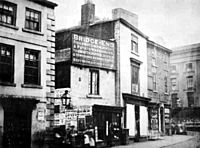
The Industrial Revolution caused Leeds to grow very quickly. By 1840, its population was over 150,000 people. This growth was helped by new transport links. The Aire & Calder Navigation (a canal system) opened in 1699, followed by the Leeds and Liverpool Canal in 1816. Railways also arrived from 1834 onwards, with the first being the Leeds and Selby Railway on September 22, 1834.
Leeds soon had several railway stations, connecting it to many other cities like Hull, York, Sheffield, Bradford, Manchester, and London.
In 1893, Leeds was officially made a city. During the Industrial Revolution, Leeds developed many industries. These included making machines for spinning, machine tools, steam engines, and gears. Other industries focused on textiles, chemicals, leather, and pottery. Coal was also mined on a large scale. The Middleton Railway, which still runs today, was the first successful commercial steam locomotive railway in the world. It carried coal into Leeds city center. Its locomotive, Salamanca, was the first to have two cylinders.
Different parts of Leeds took on different roles during this time. The city centre became a major hub for transport and trade. Hunslet and Holbeck became important engineering centers. Armley, Bramley, and Kirkstall became milling centers. Areas like Roundhay became middle-class suburbs, with the Leeds Tramway making it easier to travel to and from the city.
Leeds During Wartime
First World War
Leeds played an important part during the First World War.
Barnbow Munitions Factory
Barnbow in Cross Gates was a huge factory that made ammunition. By August 1915, it was producing 10,000 shells every week. The worst accident in Leeds's history happened here on December 5, 1916. 35 women workers, aged 14 or older, were killed in the Barnbow Munitions Factory. This factory later became the Royal Ordnance Factory Barnbow.
The plant employed 16,000 workers from Leeds and nearby towns. It even had its own railway station with a long platform to handle 38 special trains bringing workers each day. A mechanic named William Parking was given a silver watch for his bravery in saving workers during the accident.
The Leeds Pals
During the First World War, army regiments were often made up of men from the same towns. This meant that if a regiment suffered many losses, a whole town or city would lose many of its young men. Leeds was one such city. The "Leeds Pals" battalion was formed in 1914. They suffered their worst losses in the Battle of the Somme in 1916. By the Second World War, regiments were not based so much on geography.
Between the World Wars
Between the two world wars, the Leeds Women Citizens League worked to tell the national Women's Housing Sub-Committee what women needed for housing. This committee was set up in 1918 to find out what women thought about housing after the war. The Leeds group suggested things like "porcelain sinks with plugs" that children could be washed in, and having "an upstairs" in homes.
Second World War
During the Second World War, Leeds also helped with the war effort. In 1942, the people of Leeds raised over £9 million for a new ship, the third Royal Navy vessel named 'Ark Royal'. This was much more than their £5 million goal.
Bombing Raids
Leeds mostly avoided the worst of The Blitz (German bombing raids) because it was inland and didn't have many major industrial targets. However, on the night of March 14-15, 1941, Leeds experienced its heaviest bombing. Beeston had the most bombs dropped on it but suffered the least damage. Flaxton Terrace was the only street damaged during this raid. Most other bombs landed on Cross Flatts Park. Poet Tony Harrison, who was in Beeston that night, wondered if the German pilot purposely dropped the bombs in the park.
There was also significant damage in Holbeck and Headingley. The eastern side of the Town Hall was damaged. Bombs were also dropped on the Woodhouse area during nighttime raids, as the German air force tried to hit an industrial target.
Thorp Arch Factory
ROF Thorp Arch was the main ammunition factory in the area during this time. It was located near Wetherby and had large railway facilities. The factory had minor damage from bombing raids. People from all over West Yorkshire traveled by train from Leeds and Wetherby to work there.
Yeadon Factory
The town of Yeadon had an underground factory that made parts for Avro Lancaster bombers. This factory was next to the current Leeds Bradford International Airport.
Rodley Factories
Rodley, west of the city, had two factories, Smiths and Booths, that made cranes. During the war, they were changed to make bombs instead.
Leeds Today: A Modern City
By the 1900s, Leeds began to change. New academic places were created, which are now known as the University of Leeds and Leeds Beckett University. Medical care also expanded, especially at Leeds General Infirmary and St James's Hospital.
After the Second World War, many of the old industries that thrived in the 1800s declined, just like in other cities. However, Leeds recovered with the growth of new industries. These included finance, retail, call centres, offices, and media. Today, Leeds is known as one of eight "core cities" in the UK. It is generally seen as the most important city in the ceremonial county of West Yorkshire.


